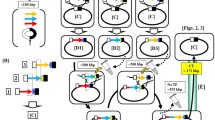Summary
Transformation in B. subtilis is achieved by the uptake of donor DNA into recipient cells and the integration of part of this donor DNA into the host chromosome. The evidence presented in this report is interpreted to indicate that donor double helical DNA, on entry into host cells is rapidly membrane bound and can remain in this state for a consicerable time, perhaps even until integration. This bound DNA consists of molecules which have been reduced in size and degraded on uptake, and appear as partially single-stranded molecules. It is suggested that the donor DNA initially forms single strands which rapidly assume a partially single stranded nature by association with the host DNA or by reannealing.
Host cells, by virtue of the competent state, possess temporarily, and prior to the addition of donor DNA, chromosomes with single-stranded gaps. It is likely that such gaps are larger than the single-stranded segments of donor DNA which are to be integrated. Results are described which are best explained if integration is achieved by an initial annealing between the single-stranded donor and host segments followed by their covalent linkage.
Similar content being viewed by others
References
Bodmer, W. F.: Recombination and integration in Bacillus subtilis transformation: Involvement of DNA synthesis. J. molec. Biol. 14, 534–557 (1965).
—, Ganesan, A. T.: Biochemical and genetic studies of integration and recombination in Bacillus subtilis transformation. Genetics 50, 717–738 (1964).
Burton, A., Sinsheimer, R. L.: The process of infection with bacteriophage ϕx174 VII. Ultracentrifugal analysis of the replicative form. J. molec. Biol. 14, 327–347 (1965).
Cahn, F. H., Fox, M. S.: Fractionation of transformable bacteria from competent cultures of Bacillus subtilis on Renograffin gradients. J. Bact. 95, 867–875 (1968).
Ephrussi-Taylor, H.: L'état du DNA transformant au cours des premières phases de la transformation bacteriènne. C. R. Acad. Sci. (Paris) 154, 1951–1955 (1960).
Erickson, R. J., Young, F. E., Braun, W.: Binding of rabbit gamma globulin by competent Bacillus subtilis cultures. J. Bact. 99, 125–131 (1969).
Harris, W. J.: Structure and function of DNA during transformation. Ph. D. thesis, University of Dundee (1969).
Harris, W. J., Barr, G. C.: Some properties of deoxyrionucleic acid in competent Bacillus subtilis. Biochem. J. 110, 38p (1968).
—: Some properties of DNA in competent Bacillus subtilis. J. molec. Biol. 39, 245–255 (1969).
Hirokawa, H., Ikeda, Y.: Genetic recombination of transforming deoxyribonucleic acid moleculus with the recipient genome and among themselves in protoplasts of Bacillus subtilis. J. Bact. 92, 455–463 (1966).
Hotchkiss, R. D., Gabor, M.: Bacterial transformation, with special reference to recombination process. Ann. Rev. Genet. 4, 193–224 (1970).
Javor, G. T., Tomasz, A.: An autoradiographic study of genetic transformation. Proc. nat. Acad. Sci. (Wash.) 60, 1216–1222 (1968).
Kammen, H. O., Beloff, R. J., Canellakis, E. S.: Transformation in Bacillus subtilis I. Role of amino acids in stabilization of transformants. Biochim. biophys. Acta (Amst.) 123, 39–55 (1966).
Lacks, S.: Integration efficiency and genetic recombination in pneumococcal transformation. Genetics 53, 207–235 (1966).
—, Greenberg, B., Carlson, K.: Fate of donor DNA in pneumococcal transformation. J. molec. Biol. 29, 327–347 (1967).
Laird, C. D., Wang, L., Bodmer, W. F.: Recombination of DNA replication in Bacillus subtilis transformation. Mutation Res. 6, 205–209 (1968).
Salton, M. L. J., Chapman, J. A.: Isolation of the membrane-mesosome structures from Micrococcus lysodeikticus. J. Ultrastruct. Res. 6, 489–498 (1962).
Smith, D. W., Hanawalt, P.: Properties of the growing point region in the bacterial chromosome. Biochim. biophys. Acta (Amst.) 149, 519–531 (1967).
Strauss, N.: Early energy-dependent step in the entry of transforming deoxyribonucleic acid. J. Bact. 101, 35–37 (1970).
Studier, F. W.: Sedimentation studies of the size and shape of DNA. J. molec. Biol. 11, 373–390 (1965).
Tichy, P., Landman, O. E.: Transformation in quasi spheroplasts of Bacillus subtilis. J. Bact. 97, 42–51 (1969).
Wolstenholme, D. R., Vermeulen, C. A., Venema, G.: Evidence for the involvement of membranous bodies in the process leading to genetic transformation in Bacillus subtilis. J. Bact. 92, 1111–1121 (1966).
Young, F. E., Spizizen, J.: Physiological and genetic factors affecting transformation of Bacillus subtilis. J. Bact. 81, 823–839 (1961).
Author information
Authors and Affiliations
Rights and permissions
About this article
Cite this article
Harris, W.J., Barr, G.C. Mechanism of transformation in B. subtilis . Molec. Gen. Genet. 113, 331–344 (1971). https://doi.org/10.1007/BF00272333
Received:
Issue Date:
DOI: https://doi.org/10.1007/BF00272333




